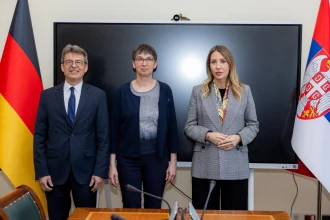The new Energy Sector Development Strategy of the Republic of Serbia until 2040, with projections until 2050, outlines ambitious goals for the decarbonisation of the energy sector without jeopardizing energy security and stability, said Veljko Kovačević, State Secretary in the Ministry of Mining and Energy.
Kovačević on the New Energy Sector Development Strategy: Ambitious Goals for Decarbonisation While Preserving Energy Security
"By 2030, the total installed capacity of wind and solar power plants should reach 3.5 GW, meaning that almost every second megawatt-hour produced will come from green energy." By 2040, capacity from RES should increase almost threefold. We can achieve these ambitious goals if the burden is shared by both the public and private sectors. We successfully initiated that process with the first auctions for market premiums from RES and expect to see significant changes in our energy portfolio by the end of this decade," Kovačević stated at the opening of the public consultation on the Draft Energy Development Strategy at the Serbian Chamber of Commerce.
The strategy envisions intensive investments in increasing energy efficiency across all sectors, as well as continued investments in the transmission network. "In the next three to four years, all sections of the Trans-Balkan Corridor should be completed. The Pannonian Corridor project, which aims to double the transmission network's capacity to Hungary, the Central Balkan Corridor, which will increase capacity to Bulgaria, and the Beogrid project, which will enable the evacuation of RES from Banat to the Belgrade region, are also planned. We will continue to invest in the distribution system, where significant investments have already begun in the reconstruction of the low-voltage network, the replacement of meters, and the digitization and automation of the distribution system," said Kovačević.
In the gas and oil sector, the priority is supply diversification, given the high dependence on imports of these energy sources. "By building the Serbia-Hungary oil pipeline, we will ensure greater security of crude oil supply. Additionally, work will be done to increase the capacity for storing the stocks of crude oil and petroleum products. In the gas sector, we will continue to focus on diversifying supply routes and sources by building interconnections to Romania, which has its own gas reserves, as well as to North Macedonia, where connections with the Southern Gas Corridor and LNG terminals are being strengthened," Kovačević stated.
According to him, the draft Strategy also promotes the preparation of Serbia for greater use of hydrogen in the energy sector through the establishment of legal regulations and the strengthening of technological and scientific research potential.
He emphasized that the topic of nuclear energy was introduced in the Draft Strategy and reminded that a Memorandum of Understanding on the implementation of nuclear energy development in the Republic of Serbia was recently signed, bringing together state institutions and the professional and scientific community. "One of the first steps to establish a broad dialogue on this topic is to lift the moratorium on nuclear energy. In the coming decades, it will be necessary to decide sustainably how we will replace the baseload energy from thermal power plants, whereas nuclear energy emerges as the best solution to ensure both supply security and carbon neutrality. We have a long way to go and a lot of work ahead of us, but the new Strategy provides an important framework for the development and improvement of our energy sector," Kovačević said.












